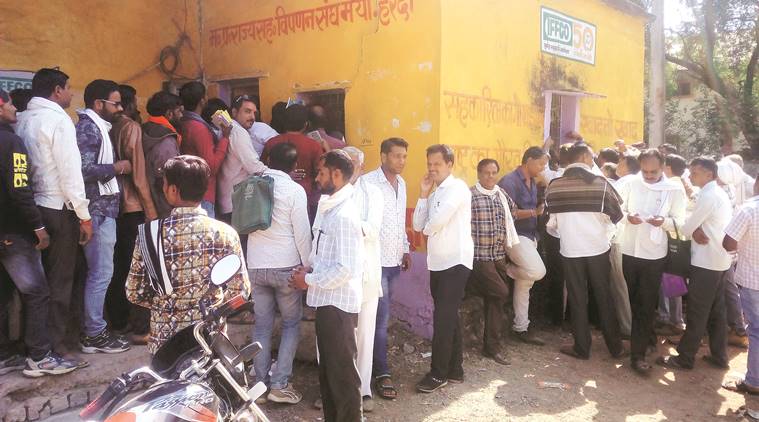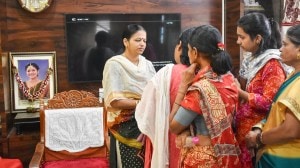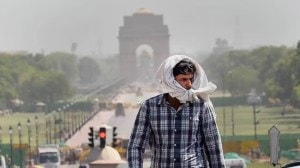- India
- International
Farm reform: From company to kisan
The Modi government is readying a plan to pay fertiliser subsidy directly to farmers through e-wallets.
 Farmers queuing up to buy urea at a retail outlet in Harda, Madhya Pradesh. (Express photo by Harish Damodaran)
Farmers queuing up to buy urea at a retail outlet in Harda, Madhya Pradesh. (Express photo by Harish Damodaran)
After introducing a system of disbursing fertiliser subsidy to companies only after actual sales to farmers registered on point-of-sale (POS) machines, the Narendra Modi government is working on moving towards full direct benefit transfer (DBT) through electronic wallets.
“We want to pay the subsidy directly to farmers, as against companies now. The idea is to give it in advance, so that the farmer doesn’t feel the burden of paying the un-subsidised maximum retail price (MRP) upfront. One way is to create an e-wallet account and transfer money to that before the kharif or rabi planting season. The e-wallet may be used only for purchase of fertiliser through POS machines. The money transferred would be non-lapsable; the unspent amounts can be taken forward to the next season,” a top official told The Indian Express.
Currently, the subsidy on di-ammonium phosphate (DAP) is a flat Rs 10,402 per tonne, while it is retailing at about Rs 25,000. The per-tonne subsidy on complex fertilisers with different nitrogen (N), phosphorous (P), potash (K) and sulphur (S) combinations is similarly Rs 8,739 for 10:26:26, Rs 8,917 for 12:32:16 and Rs 7,286 for 20:20:0:13, while their MRPs, depending upon the company, average around Rs 24,000, Rs 24,200 and Rs 20,000 per tonne, respectively. The subsidy is even higher on urea, ranging from Rs 23,000 for gas-based to Rs 38,000 per tonne for naphtha-based plants. Its MRP, unlike other “decontrolled” fertilisers, is fixed at Rs 5,360 per tonne.
Also Read | August push: Monsoon recovery spurs nutrient sales
If the existing system of paying subsidy to the fertiliser manufacturer or importer is replaced by DBT, farmers will shell out higher MRPs. But net of the subsidy, made as an e-wallet transfer ahead of the season, they would effectively pay the same rates. “Implementing this is a political decision. They (Modi government) would obviously want it to be totally foolproof, so as to not invite any farmer backlash from a sudden increase in MRPs and having to pay upfront,” the official pointed out.
Till early last year, companies were paid subsidy after their fertiliser had been dispatched and received at the railhead point or approved godown of a district. But from March 2018, a new so-called DBT scheme — it really isn’t one, as the subsidy is still going to companies and not farmers — has been put in place. Companies are now being paid only after actual sales to the farmer happens.

“In the earlier system, there was scope for diversion of subsidised fertilisers, right from the point of dispatch till the retailer end. This was first addressed by making neem-coating of urea, whether domestically-produced or imported, mandatory from December 2015. It helped stop urea diversion for adulteration of milk (neem oil leads to its curdling). However, unscrupulous animal feed, melamine, plywood and particle board makers have found a way around using even neem-coated urea,” the official noted.
 A fertiliser point-of-sale machine. (Express photo by Bhupendra Rana)
A fertiliser point-of-sale machine. (Express photo by Bhupendra Rana)
Under the new scheme, any manufacturer or importer has to make an entry into ‘e-Urvarak’ — the DBT platform of the department of fertilisers — the moment its bagged material is dispatched from the factory or port. When this consignment reaches the particular warehouse or rake unloading point, the company’s representative there is required to acknowledge its receipt and also enter the system. Similar dispatch and receiving-point entries have to be made again, when the fertiliser moves to the wholesaler and the retailer. The DBT system can, thus, identify any discrepancies in the fertiliser supply quantities between the manufacturer/importer and the retailer.
The country has over 2.25 lakh fertiliser retail outlets where POS machines have been installed, with all sales now being done through these devices. A farmer wanting to buying urea or DAP has to furnish his Aadhaar, voter identification or Kisan credit card number. The quantities of the individual fertilisers purchased, along with the farmer’s name and biometric authentication, have to be captured on the POS machine that linked to the e-Urvarak central server. Only upon the farmer getting a printed receipt, and the sale transaction being registered on the device/system, is the company eligible to receive the subsidy.
“The companies will generate bills based on these transactions and make their consolidated claims online to the department’s subsidy branch. Subject to fund availability, the subsidy (budgeted at Rs 79,996 crore for 2019-20) is released on the first-in, first-out or FIFO principle: The bills submitted first get precedence over the next,” the official explained.
In 2018-19 (April-March), a total 575.69 lakh tonnes (lt) of fertiliser was sold to farmers. That included 320.20 of lt urea, 87.37 lt DAP, 27.36 lt muriate of potash, 95.77 lt complex fertilisers, 43.31 lt single super phosphate and 1.62 lt compost. “The entire quantity was retailed through POS machines and over 90% transactions Aadhaar-authenticated. Only in Jammu & Kashmir and the northeastern states have we permitted sales against voter ID or Kisan credit card, but even these have to be through POS,” the official claimed.
It hasn’t been completely smooth running, though. “There are times when the internet does not work. Fertiliser sales peak in June-August (for kharif) and November-January (for rabi). The retailer may have to handle 200-250 farmers daily during this season and they cannot be denied fertiliser because of no connectivity. In such instances, he would resort to manual transactions or make sales to multiple farmers using a single Aadhaar authentication,” he admitted.
But on the whole, the new system has significantly eliminated diversion of subsidised fertilisers. Some pilferage might be happening at the retail level, as the Modi government is still following a “no-denial” policy: Anybody, non-farmers included, can technically buy any quantity of fertiliser through POS machines now, subject to their furnishing Aadhaar biometric or other authentication.
The fertiliser department’s online DBT platform has, nevertheless, generated a database with considerable granularity that allows for weeding out of non-deserving beneficiaries. “We have written to state governments to use this database to identify the top 20 buyers or those purchasing frequently at a district level. They can find out whether the quantities bought are justified by their operational holdings, crops sown, etc. Restricting the subsidy to genuine farmers and also capping the number of such bags sold per holding could be an intermediate step before we move to full DBT,” the official said.
Full DBT would, first of all, require the payments to farmers being made sufficiently in advance. They, unlike companies, cannot afford delayed release of subsidy. A repeat of the experience vis-à-vis goods and services tax — pending refunds and blockage of working capital — would be a disaster, economically and politically.
“We may give the subsidy on a per-acre or per-kg of nutrient (NPKS) basis. One-third of the money can be credited before the season and the balance two-thirds transferred in two installments during the season. The farmer will, then, be able to buy the fertiliser of his choice, while factoring in the per-kg nutrient/per-acre subsidy. We will ensure that the MRPs, even after they go up, are within a band and far-flung areas face no shortages. The government would also retain movement controls — the right to direct companies to sell up to 20% of their production/imports as per mutually agreed supply plans,” the official added.
Apr 26: Latest News
- 01
- 02
- 03
- 04
- 05








































